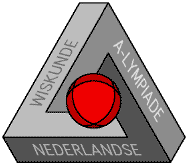 Math A-lympiad:
Final 1995-1996
Math A-lympiad:
Final 1995-1996
Predicting the number of university students in the Netherlands
Introduction
In recent years there were a lot of changes in the number of first
year (or: entering) university students at Dutch universities. Beside changes
in the total number of students, also a number of shifts can be seen, for
instance: shifts between technical studies and social studies, as well
as shifts between different universities. Further, the popularity of specific
studies has hanged over time.
For the Dutch universities as well as for the Dutch politics it is important
to know why these changes in the numbers of students and the shifts between
studies and universities occur, and what to expect in the near future.
It can easily be understood that demographic factors - these are factors
that concern population-growth and populationstructure, like families having
fewer children and people getting children at a later age -, have a strong
impact. Also, the fact that it is nearly impossible to get a good job based
on a high school {secondary school, age 12-18} degree only, is an important
factor. Furthermore, polital decisions on economizing on scholarships and
number of years, allowed to study, will cause difficulties in going from
HBO to university. Finally, all kinds of economical developments,
particularly concerning employment, like the closing of business and industry,
have an effect on the choices future students make.
Data
In the appendices you will find large numbers of data. Most of these
are taken from the 1995 yearbook of Statistics, a publication from the
Dutch central bureau of statistics. You will have to decide for yourselves
which of these data are useful when answering the questions and how these
data can best be used and combined.
Task
The Union of Cooperating Dutch Universities (UCDU) has asked your team
to write a report, in which predictions will be made on numbers of first
year students for the next 5 years.
The report should contain an elaboration of the following parts (devote
at least one "chapter" of the report on each part):
-
Based on the data, make an estimation for the total number of first year
students to be expected to enter all Dutch universities together in september
1995 up to and including 1999.
-
Investigate which shifts have occured in the last five years between student
numbers over the different categories of studies Agriculture, Physical
sciences, Technical sciences, Health, Economics, Law, Social studies, Language
and culture and try to explain those shifts. Predict how the first year
students of 1995 up to and including 1999 will be distributed among those
categories of studies.
-
The UCDU is also interested in knowing how many first year students will
enter each of the universities the next five years. Find a method to predict
these numbers. Just a limited number of data is available on this subject;
indicate which data possibly could have been useful, to come to a good
prediction of the number of first year students.
You might illustrate your method, using the information that is available
on the University of Groningen.
Don't forget to include your 'way of working', what data you used, what
assumptions you made, your approach or line of reasoning, and try to say
something about the reliability of the predictions.
 Math A-lympiad:
Final 1995-1996
Math A-lympiad:
Final 1995-1996 Math A-lympiad:
Final 1995-1996
Math A-lympiad:
Final 1995-1996